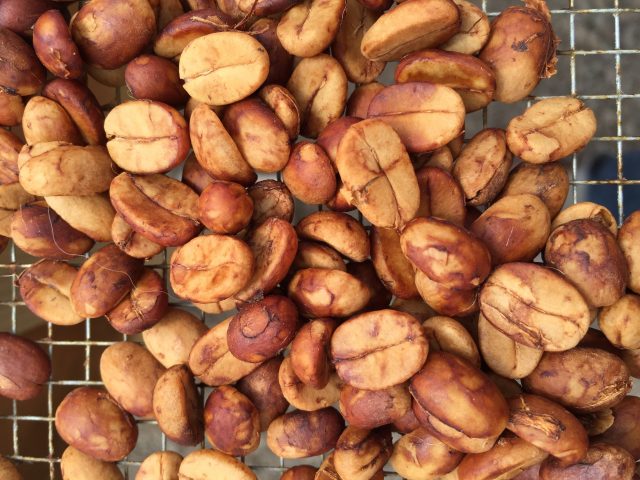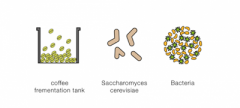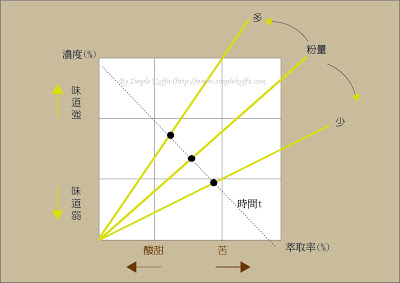How does the fermentation of raw beans affect the flavor of coffee?
For professional baristas, please follow the coffee workshop (Wechat official account cafe_style)
Sasa, winner of the 2015 World Barista Competition, uses an innovative fermentation process called washing carbon dioxide impregnation, and two years later he has his own estate and is more involved in fermentation technology.
In fact, at the Budapest World Competition in June 17, Sasa gave a speech on controlling the flavor, quality and price stability of fermentation treatment, and he agreed to provide us with some of the information of the speech.

Coffee with endocarp after fermentation, source: Ka'u Specialty Coffee
Why are we talking about fermentation?
Sasa mentioned that we know little about fermentation, but it is very important.
He said at the meeting: "I flew to countries around the world to taste coffee and tested the coffee processing process with more than 50 farmers. I also experimented on my own farm and found that there were too many unstable factors in the traditional treatment methods in the past. The most unstable of which is the effect of fermentation.
He mentioned that in fact, there are some examples of how fermentation can improve or reduce the quality of coffee or even reach an eight-point difference. When most boutique coffee scores are defined at 80-92 out of 100, eight is a startling difference.

Iced coffee in Sasa experiment, cup score was 87.5 points, source: Sasa Sestic
What is fermentation?
Simply put, fermentation is the process by which sugars and starches break down into acids or alcohol. Let's delve deeper. Sasa says yeast and bacteria are important for fermentation.
Yeast fermentation, called Saccharomyces cerevisiae, is a natural wild yeast that is also found in grapes, cocoa beans and other fruits. At present, it is used in wine making, cocoa bean treatment and coffee treatment. "
And the strain is lactic acid bacteria.
During the natural fermentation of coffee, different biodegradation procedures take place, and enzymes produced by yeasts and bacteria begin to decompose the sugar in the pectin layer. Sugar breaks down lipids, proteins and acids and converts them into alkyd, which changes the smell, color, pH and composition of the pectin layer of coffee beans.
Sasa also said that there are many different fermentation methods in the world, but they are mainly divided into dry fermentation and wet fermentation.

2017 fermentation composition diagram shown at Sasa in Hungary
Dry fermentation and its flavor
"after we remove the pulp, we put the coffee with endocarp in the fermentation tank, and the fermentation promotes the sweetness, chocolate and fruit flavor of the coffee." but one of the challenges of fermentation is temperature control. Since temperature can affect the degree of fermentation, it will also negatively affect the stability and flavor of the process.

Effect of temperature on dry fermentation, source: Sasa Sestic
The diagram on the left side of the dotted line above shows that we ferment the coffee at an average temperature of 16 degrees for 24 hours. The coffee tastes great and the flavor is well balanced.
The right side of the image above represents fermentation at a temperature of 26 degrees for 24 hours, with marked pink blocks, which can occur when the fermentation is too long, and alcoholic acids dominate the fermentation, resulting in excessive acetic acid, dryness and metallic taste.
Wet fermentation and its flavor
You may have heard someone describe wet fermentation as double washing, double fermentation, Kenyan washing, etc., which is common in East African countries and is famous for its clean and clear flavor, but Sasa describes this treatment as adding flavor to the cup.
"when we remove the pulp and put the coffee with endocarp into the water, the water will help prolong the fermentation time, resulting in a softer mellow thickness, rich acidity and more elegant flavor characteristics of the coffee. "

Fermentation tank built by the inspection program in Ethiopia, source: Project Origin
Of course, this does not mean that the treatment is not challenging. Sasa mentioned that temperature and water quality can also affect the results.
Sasa: "A few years ago, I did an experiment with Raul Riviera, the owner of Santa Rosa in El Salvador. We used Rain Water instead of spring water to ferment. Rain Water would absorb a lot of fruit flavor and sugar from the coffee fruit. As a result, the cup test score was reduced by five points. The coffee tasted insipid and had no distinct flavor. The effects of the water used for fermentation still need to be studied. "

The left side of the picture above shows the coffee fruit soaked in spring water for 30 hours, with a ph value of 7.5 / TDS 180.
The right side of the image above shows Rain Water's coffee fruit soaked for 30 hours, with a ph value of 6.5 / TDS 30.
Source: Sasa Sestic
More data makes better coffee
Sasa is one of the leaders in coffee treatment experiments, from his novel ice treatment (which will be a trade secret until his book is published) to the famous washing carbon dioxide impregnation.
Due to the lack of related research in the coffee industry, Sasa began its research with wine and beer brewing technology. Sasa: "Tim Kirk, the owner of Clonakilla winery, helps me a lot and gives me a lot of inspiration. His winery is in my hometown of Canberra."
"when I first visited Tim, I was impressed by his equipment. He knew very well where Rain Water would land in the vineyard, and he knew very well the temperature of the wind and how it would affect the flavor of the wine. It's really fascinating. I have never seen anyone know so much about climate and how it affects products.

Tim Krk of Clonakilla winery explains the cause of wine fermentation, source: Sasa Sestic
But Tim is not apt to describe the weather like the back of his hand, because he can even control it.
Tim can control the temperature and humidity of the environment during fermentation. He says that as long as he controls different temperature and time, he can make the wine reach different flavor levels.
He uses a double-layer insulated stainless steel container to increase the clarity of the fermentation. He will monitor and record pH, alcohol and carbon dioxide concentrations to ensure that he achieves the desired brewing results.
This data-driven approach has led Sasa to change the way he handles coffee.

Stainless steel fermentation tank of Clonakilla winery, source: Sasa Sestic
Fermentation experiment
"imagine a cup of water-washed and tanned coffee with great flavor and distinctive characteristics. I want to create a treatment technology that can give full play to the aroma and flavor of coffee and have a good balance between sour and sweet taste. And then more importantly, I want to create so that this technology can be replicated on the farm side, just as Tim does with his wine. "
The following is the process flow of Sasa:
Step 1
First of all, remove the skin and pulp from the stainless steel bucket. "stainless steel is used because we can process coffee with a cleaner flavor, and we can move the container according to the temperature of the space; we can also seal these buckets. "
Step 2
Next, move the bucket indoors, where the temperature is easier to control, but Sasa is still collecting data on how this affects coffee processing. However, he has observed some valuable conclusions: "if you want to get rich acid, you should ferment at a lower temperature (4-8 °C)." To get more sweetness, use higher temperature fermentation (18-20 °C).

Coffee fruits in stainless steel barrels before fermentation process, source: Ka u Specialty Coffee
Step 3
Next, seal the bucket. "In my experience, this stage develops more aromas, adding flowers to the coffee."
Step 4
Finally, and most importantly, carbon dioxide is injected. "The reason we chose to inject carbon dioxide is that as long as there is no oxygen, it will reduce the decomposition of sugar in the pectin layer, and the pH change will also be greatly reduced, which means that we can reduce the production of alcoholic acids."
"Carbon dioxide can extend fermentation times up to three days at 22 ° C, and even longer at low temperatures without developing the dry and acrid taste that usually occurs in dry fermentation for three days."
Sasa wants to master every step of the data like Tim."We also measure and record the pH, CO2 concentration and temperature of the fermentation process, and then we can replicate these fermentation conditions every time."

Carbon dioxide impregnation: carbon dioxide is injected and oxygen is discharged. Source: Sasa Sestic
Continuous improvement method
Sasa is not satisfied with his title: he urges himself to find more ways to improve the flavor of coffee through fermentation. "Last year, I had coffee from Jamison, Morgon Manor in Panama, and it was delicious. But I wanted more sweetness, deeper flavor, and more floral flavor, so after a few cups of yellow soup, we decided to do carbon dioxide impregnation. "
But this is different from the carbon dioxide impregnation method that has been operated in the past. "We decided to ferment coffee at a higher temperature of 20 °C to promote the sweetness of coffee, and to extend the time of carbon dioxide impregnation fermentation to 65 hours to promote the development of more flavor richness. "as a result, we get more sweetness, better texture and clearer flavor characteristics. "in the end, the cup test score of coffee increased by 2.5 points. "said Sasa.

Fermentation monitoring curve, from Sasa Sestic2017's speech in Hungary.
Through this treatment, he brings the desired flavor, and they provide more opportunities for consumers, baristas, coffee contestants to get good coffee, and producers can get a stable good selling price.
"from my point of view, I believe there is no perfect variety of coffee, and there is no perfect way to handle it. However, if we can understand the potential flavor characteristics of different coffee varieties, as well as their advantages and disadvantages, and deal with them through carbon dioxide impregnation or other controlled fermentation methods, we can enhance the advantages and disadvantages of these coffees. When we get good processing data in the fermentation process, we can replicate this beautiful flavor.
Original source:
Https://www.perfectdailygrind.com/2017/07/fermentation-affect-coffee-flavour-development/
Important Notice :
前街咖啡 FrontStreet Coffee has moved to new addredd:
FrontStreet Coffee Address: 315,Donghua East Road,GuangZhou
Tel:020 38364473
- Prev

Explanation on the fermentation mode of raw coffee beans: the difference between dry fermentation and wet fermentation and the scope of application
Exchange of professional baristas Please pay attention to the coffee workshop (Wechat official account cafe_style) coffee beans fermented taste is not a sign of poor quality? The fermentation treatment of raw coffee beans is divided into dry and wet dry fermentation, which is subdivided into Brazilian, Yemeni and Chinese-American (it's really complicated). In the case of Brazilian beans, dry fermentation is derived because of the local lack of water.
- Next

[Dry goods] Listen to champion Wu Zelin's analysis of "Gold Cup Theory"
Professional barista communication please pay attention to coffee workshop (Weixin Official Accounts cafe_style) around more and more friends playing coffee, some of whom are very serious about coffee this thing, often put forward some constructive, reference value experience or experience, of course, will also extend a variety of problems to be explained to be clarified to be confirmed. There have been a lot of fans lately.
Related
- What is the meaning of lactic acid fermentation with coffee bean treatment?
- How to judge the state of foam by sound?
- How does the latte pull out the unicorn pattern? Come to get for a little trick to improve the flower pull!
- Will flower pulling affect the taste of the latte?
- Do you know the history of coffee?
- The difference between honey treatment and sun washing what is raisin honey treatment?
- What kind of milk can a novice use to make coffee foam to keep the foam longer? The correct method and skills of milking tutorial sharing
- Why do washed coffee beans taste sour? Flavor characteristics of washed Coffee
- Introduction to the skill of how to practice the size and height of water injection around the circle of hand-brewed coffee
- How do beginners practice coffee flower drawing from scratch?

